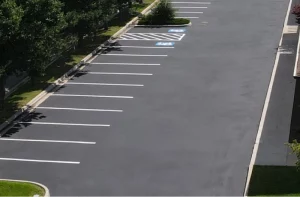The Importance of Patching Asphalt in Parking Lots
Asphalt parking lots endure heavy traffic, changing weather conditions, and natural wear and tear over time. Cracks, potholes, and surface deterioration are inevitable, but if left unattended, they can lead to costly repairs, safety hazards, and a poor impression of your business. Patching asphalt promptly and properly is a critical part of maintaining your parking lot, preserving its longevity, and ensuring a safe, attractive environment for customers and visitors. In this blog post, we’ll dive into why patching asphalt in parking lots is so important and how it benefits both property owners and users.
1. Prevents Further Damage and Costly Repairs
One of the primary reasons to patch asphalt as soon as damage appears is to prevent it from worsening. Even small cracks and potholes can lead to significant damage if left unaddressed.
- Water Infiltration: Cracks and potholes allow water to seep into the underlying layers of the pavement. When water penetrates these layers, it can weaken the base and lead to further cracking, potholes, or complete pavement failure. In colder climates, the freeze-thaw cycle can exacerbate the issue, causing water trapped in the pavement to freeze, expand, and cause additional damage.
- Costly Resurfacing or Replacement: Ignoring small damages can eventually lead to large-scale problems that require extensive resurfacing or even full replacement of the asphalt. Patching early on is a cost-effective way to address minor issues before they escalate into expensive repairs. Regular patching extends the life of your parking lot, saving you significant costs in the long run.
2. Enhances Safety for Drivers and Pedestrians
Safety is a top priority for any parking lot, and damaged asphalt can pose serious risks to both vehicles and pedestrians.
- Preventing Accidents: Potholes, cracks, and uneven surfaces increase the risk of accidents, including vehicle damage or trips and falls for pedestrians. A well-maintained parking lot with properly patched surfaces reduces these hazards, creating a safer environment for everyone who uses your lot.
- Liability Reduction: In addition to improving safety, patching asphalt helps minimize your liability as a property owner. If a customer or visitor is injured due to neglected asphalt damage, you could be held responsible for the accident. Regularly patching damaged areas reduces the risk of accidents and protects your business from potential liability claims.
3. Improves Aesthetic Appeal and Customer Perception
Your parking lot is often the first thing customers see when they visit your business. A smooth, well-maintained lot creates a positive first impression, while a lot riddled with cracks and potholes can give the impression that your business is unkempt or poorly managed.
- Curb Appeal: A clean, smooth parking lot enhances the overall aesthetic of your property. Patchwork that eliminates unsightly potholes and cracks contributes to a more polished and professional look, improving the curb appeal of your business. This can make a significant difference in how customers perceive your establishment, as a well-maintained exterior reflects positively on the business as a whole.
- Competitive Advantage: In competitive markets, a parking lot in good condition can set you apart from neighboring businesses. Customers are more likely to choose a business with a safe, clean, and easy-to-navigate parking lot over one that is riddled with potholes or cracks.
4. Increases the Longevity of Your Parking Lot
Patching asphalt not only addresses current damage but also helps preserve the overall integrity of your parking lot, extending its lifespan.
- Maintains Pavement Structure: By filling cracks and patching potholes, you prevent damage from spreading to other areas of the pavement. This helps maintain the structure and stability of the entire parking lot. Regular patching, combined with other maintenance measures like sealcoating, keeps your asphalt in better condition for a longer period, delaying the need for major repairs or replacement.
- Maximizing ROI: Asphalt parking lots represent a significant investment. By regularly patching and maintaining your lot, you protect that investment and maximize the return on it by extending the useful life of the pavement.
5. Reduces Environmental Impact
Asphalt patching, when done correctly, can also contribute to environmental sustainability. Rather than replacing large sections of damaged asphalt, patching allows you to repair only the affected areas, reducing waste and the need for new materials.
- Recycling Asphalt: Many asphalt patching processes use recycled asphalt materials, further minimizing the environmental footprint of repairs. This not only conserves resources but also reduces energy consumption associated with manufacturing new asphalt.
- Lower Carbon Footprint: Smaller patching projects require less equipment and fewer materials than full-scale asphalt resurfacing or replacement, leading to a lower overall carbon footprint for your parking lot maintenance.
6. Improves Drainage and Reduces Pooling Water
Damaged asphalt, particularly when potholes form, can create uneven surfaces that disrupt the natural drainage of your parking lot. This can lead to water pooling in certain areas, which further deteriorates the asphalt and creates hazards for both vehicles and pedestrians.
- Better Drainage: By patching potholes and cracks, you ensure that your parking lot maintains its proper grade, allowing water to flow into designated drainage areas. Improved drainage prevents water from collecting on the surface, reducing the risk of erosion, additional cracks, and pavement degradation.
- Prevention of Ice Formation: In colder climates, water that pools in cracks or potholes can freeze during winter months, leading to dangerous ice patches in your parking lot. Properly patching damaged asphalt reduces the risk of ice formation, improving safety for everyone using the lot.


